INSTITUT SUPERIEUR D'ANTHROPOLOGIE
INSTITUTE OF ANTHROPOLOGY
ONLINE COURSES / COURS A DISTANCE
SPRING TERM : APRIL 2015
REGISTER NOW
TURQUIE – 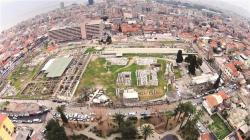 Izmir - An expropriation process has been continuing in the historic Agora in the center of İzmir since 1997, and archaeologists in the Kadifekale neighborhood have recently extended the site’s excavation field with the support of the local metropolitan municipality.As part of recent work, some buildings next to the Çankaya car parking lot have been expropriated and a number of streets have been closed to traffic to be included in the excavation field. The municipality also surrounded the Smyrna Agora with a specially designed wall in order to protect the historic site. The three-meter-high and 180-meter-long wall helps reveal the beauty of the agora and has places for visitors to rest. The first expropriation in the historic area took place in 1997, while authorities began removing buildings in 2005.
Izmir - An expropriation process has been continuing in the historic Agora in the center of İzmir since 1997, and archaeologists in the Kadifekale neighborhood have recently extended the site’s excavation field with the support of the local metropolitan municipality.As part of recent work, some buildings next to the Çankaya car parking lot have been expropriated and a number of streets have been closed to traffic to be included in the excavation field. The municipality also surrounded the Smyrna Agora with a specially designed wall in order to protect the historic site. The three-meter-high and 180-meter-long wall helps reveal the beauty of the agora and has places for visitors to rest. The first expropriation in the historic area took place in 1997, while authorities began removing buildings in 2005.
http://www.hurriyetdailynews.com/agora-excavation-perimeter-extended-.aspx?pageID=238&nID=77464&NewsCatID=375
ROYAUME UNI – Buntingford - An insight into the lives of Buntingford’s earliest inhabitants has been unearthed. An Iron Age roundhouse and farmstead dating back more than 2,000 years have been discovered by archaeologists at the site of the Knights Walk development off Hare Street. Objects found in the dig, which took place in October and November, included animals bones, the remains of a kiln and one of the most significant Iron Age pottery finds in the county. Mr Crawford-White said that the finds dated back to 400-100BC. He said: “Near to the Iron Age house was a large ditched enclosure, where cattle would have been kept and we found a number of ‘four post’ structures for the storage and dispensing of fodder for the animals. “The settlement continued to be lived in for several hundred years and into the later Iron Age, when the inhabitants built a second large ditched enclosure in the north of the site, across what would once have been a small stream.” The centuries of occupation by the Iron Age inhabitants continued until the 1st century AD, when the Roman invasion of Britain took place. “The Roman period saw the expansion of town life and the people living here may well have been incorporated into new towns and villages along the Roman road of Ermine Street,” Mr Crawford-White added.
http://www.hertfordshiremercury.co.uk/Iron-Age-finds-reveal-Buntingford-s-earliest/story-25913015-detail/story.html
FRANCE – 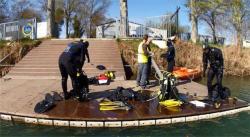 Agde - La campagne annuelle de fouilles subaquatiques du site de la Motte à Agde va se dérouler du 9 au 27 février 2015. Elle réunit les plongeurs spécialisés en Archéologie de l’Association IBIS et plusieurs chercheurs du CNRS ou des universités du sud de la France. Ces recherches du Ministère de la Culture bénéficient de l’aide complémentaire du Département, de l’agglomération Hérault Méditerranée et de la municipalité d’Agde. L’opération intéresse les vestiges noyés, dans le fleuve Hérault, d’un établissement à plusieurs centaines de pieux de bois plantés de la fin de l’Âge du bronze. Les aménagements des berges de la lagune située il y a près de 2900 ans avant notre ère dans le delta du fleuve livrent les ruines d’habitations d’une petite communauté protohistorique. Les conditions exceptionnelles de conservation du site sous 5 m d’eau douce et son étendue apportent de précieuses informations, inconnues ou très rarement réunies en milieu terrestre (végétaux, insectes) et illustrent la vie quotidienne des populations agathoises du Ier millénaire avant J.-C. Le site a probablement connu une occupation assez longue comme la stratigraphie du site forte de plus de 2 m de puissance l’indique. L’étude de l’environnement du site est complétée par des carottages sédimentaires. Ils décrivent l’évolution d’un plan d'eau saumâtre, en très bonne communication avec la mer, qui se colmate progressivement à proximité de l’embouchure du fleuve. Cette position géographique particulière caractérise les installations de la fin de l’âge du bronze. L’ensemble très abondant des céramiques découvert dans ces horizons successifs documente une culture régionale de la fin de l’Âge du bronze plusieurs siècles avant la venue des colons grecs sur la côte. Les travaux engagés en 2015 concerneront tout particulièrement la poursuite de l’étude de l’extension du site, en surface comme en épaisseur, et celle de la zone est du site où un grand clayonnage de branches tressées est en cours d’étude. Les recherches dendro-chronologiques (datation à partir des cernes du bois) réalisées à partir des prélèvements de pieux (chênes, ormes en écrasante majorité) s’annoncent très favorables avec la synchronisation de plusieurs pièces de bois. Cette opportunité, exceptionnelle en Languedoc et dont les résultats vaudront pour un grand territoire méridional, permet d’envisager l’affinement chronologique des aménagements (saison et année) et une appréciation précise de l’organisation des installations. L’avancement des travaux est seul conditionné aux difficultés particulières de la fouille en milieu subaquatique: logistique lourde, équipement technique, turbidité et température des eaux, etc.
Agde - La campagne annuelle de fouilles subaquatiques du site de la Motte à Agde va se dérouler du 9 au 27 février 2015. Elle réunit les plongeurs spécialisés en Archéologie de l’Association IBIS et plusieurs chercheurs du CNRS ou des universités du sud de la France. Ces recherches du Ministère de la Culture bénéficient de l’aide complémentaire du Département, de l’agglomération Hérault Méditerranée et de la municipalité d’Agde. L’opération intéresse les vestiges noyés, dans le fleuve Hérault, d’un établissement à plusieurs centaines de pieux de bois plantés de la fin de l’Âge du bronze. Les aménagements des berges de la lagune située il y a près de 2900 ans avant notre ère dans le delta du fleuve livrent les ruines d’habitations d’une petite communauté protohistorique. Les conditions exceptionnelles de conservation du site sous 5 m d’eau douce et son étendue apportent de précieuses informations, inconnues ou très rarement réunies en milieu terrestre (végétaux, insectes) et illustrent la vie quotidienne des populations agathoises du Ier millénaire avant J.-C. Le site a probablement connu une occupation assez longue comme la stratigraphie du site forte de plus de 2 m de puissance l’indique. L’étude de l’environnement du site est complétée par des carottages sédimentaires. Ils décrivent l’évolution d’un plan d'eau saumâtre, en très bonne communication avec la mer, qui se colmate progressivement à proximité de l’embouchure du fleuve. Cette position géographique particulière caractérise les installations de la fin de l’âge du bronze. L’ensemble très abondant des céramiques découvert dans ces horizons successifs documente une culture régionale de la fin de l’Âge du bronze plusieurs siècles avant la venue des colons grecs sur la côte. Les travaux engagés en 2015 concerneront tout particulièrement la poursuite de l’étude de l’extension du site, en surface comme en épaisseur, et celle de la zone est du site où un grand clayonnage de branches tressées est en cours d’étude. Les recherches dendro-chronologiques (datation à partir des cernes du bois) réalisées à partir des prélèvements de pieux (chênes, ormes en écrasante majorité) s’annoncent très favorables avec la synchronisation de plusieurs pièces de bois. Cette opportunité, exceptionnelle en Languedoc et dont les résultats vaudront pour un grand territoire méridional, permet d’envisager l’affinement chronologique des aménagements (saison et année) et une appréciation précise de l’organisation des installations. L’avancement des travaux est seul conditionné aux difficultés particulières de la fouille en milieu subaquatique: logistique lourde, équipement technique, turbidité et température des eaux, etc.
http://www.herault-tribune.com/articles/25910/fouilles-archeet769%3Bologiques-site-de-la-motte-aet768%3B-agde-du-9-au-27-feet769%3Bvrier-2015/
FRANCE –  Vasles - Vestige des anciens fours à chaux qui jalonnaient le chemin qui va de la Coursaudière à la Frictière, sur la commune de Vasles, le seul four à chaux qui reste se découvre, suite à la coupe des arbres qui le cachaient jusqu'alors au regard des promeneurs. Dans l'inventaire du patrimoine industriel du Poitou-Charentes, il est ainsi décrit : « Ce massif cubique, aux murs talutés d'environ 6 m de côté, est maçonné en gros moellons équarris. La gueule, en plein cintre, mesure environ 2,60 m de large sur 3 m de profondeur. Le gueulard fait environ 2,50 m de diamètre ». Actuellement situé sur un terrain privé et à l'abandon, ce four à chaux a été bâti à la fin du XIXe siècle pour M. Chauvin. Le calcaire était extrait dans des carrières aux alentours, dont plusieurs se trouvaient sur le même chemin. Dans ces terrains composés d'argile et de silex, il fallait creuser parfois profondément pour trouver des filons de calcaire. Des traces restent de ces carrières (parfois utilisées malheureusement comme décharges sauvages ou officielles) et des plans inclinés qui permettaient à des wagons d'amener le calcaire dans la gueule du four : le gueulard. Dans ce four, le combustible utilisé était du bois. On intercalait une couche de bois, une couche de calcaire et on mettait en chauffe, pendant plusieurs jours. Le travail des chaufourniers était un travail pénible. Surtout lorsqu'il fallait récupérer la chaux vive à la sortie. Les Chauvin exploitèrent les fours de ce chemin jusqu'en 1933.
Vasles - Vestige des anciens fours à chaux qui jalonnaient le chemin qui va de la Coursaudière à la Frictière, sur la commune de Vasles, le seul four à chaux qui reste se découvre, suite à la coupe des arbres qui le cachaient jusqu'alors au regard des promeneurs. Dans l'inventaire du patrimoine industriel du Poitou-Charentes, il est ainsi décrit : « Ce massif cubique, aux murs talutés d'environ 6 m de côté, est maçonné en gros moellons équarris. La gueule, en plein cintre, mesure environ 2,60 m de large sur 3 m de profondeur. Le gueulard fait environ 2,50 m de diamètre ». Actuellement situé sur un terrain privé et à l'abandon, ce four à chaux a été bâti à la fin du XIXe siècle pour M. Chauvin. Le calcaire était extrait dans des carrières aux alentours, dont plusieurs se trouvaient sur le même chemin. Dans ces terrains composés d'argile et de silex, il fallait creuser parfois profondément pour trouver des filons de calcaire. Des traces restent de ces carrières (parfois utilisées malheureusement comme décharges sauvages ou officielles) et des plans inclinés qui permettaient à des wagons d'amener le calcaire dans la gueule du four : le gueulard. Dans ce four, le combustible utilisé était du bois. On intercalait une couche de bois, une couche de calcaire et on mettait en chauffe, pendant plusieurs jours. Le travail des chaufourniers était un travail pénible. Surtout lorsqu'il fallait récupérer la chaux vive à la sortie. Les Chauvin exploitèrent les fours de ce chemin jusqu'en 1933.
http://www.lanouvellerepublique.fr/Deux-Sevres/Communes/Vasles/n/Contenus/Articles/2015/01/24/Un-ancien-four-a-chaux-se-decouvre-2197373
ESPAGNE – 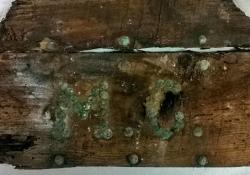 Madrid - In 1616, Cervantes died and was buried at the Convent of the Barefoot Trinitarians in Madrid's Barrio de las Letras (the Literary Quarter), but in 1673 his bones went missing during building work, after they were taken to another convent and then returned and interred somewhere inside.Since April 2014, a group of archaeologists and anthropologists have been searching the tiny convent chapel for his remains using an endoscope camera inserted through tiny holes and a geo-radar device mounted on wheels to scan beneath the chapel's floors. Eventually, three unrecorded and unidentified graves in the chapel's crypt were marked for excavation, and on Saturday (24 January), the team of archaeologists and anthropologists discovered a wooden coffin marked with the initials MC in nails. A collection of bones belonging to both children and adults were found interred 4.8 metres beneath the floor of the crypt, and there are a mix of bones in the wooden coffin that could contain Cervantes. All the bones are now being exhumed and separate, with forensic specialists examining key details, such as the brow ridges, which . The archaeologists are not certain whether any male remains found in the casket will be a match to Cervantes. "Were we to find remains that fulfil the characteristics we are looking for, we could possibly pass to a next stage. That would be to compare DNA similarities with his sister, but that is a very complex step," said Francisco Etxeberria, a forensic medicine specialist from the University of the Basque Country.
Madrid - In 1616, Cervantes died and was buried at the Convent of the Barefoot Trinitarians in Madrid's Barrio de las Letras (the Literary Quarter), but in 1673 his bones went missing during building work, after they were taken to another convent and then returned and interred somewhere inside.Since April 2014, a group of archaeologists and anthropologists have been searching the tiny convent chapel for his remains using an endoscope camera inserted through tiny holes and a geo-radar device mounted on wheels to scan beneath the chapel's floors. Eventually, three unrecorded and unidentified graves in the chapel's crypt were marked for excavation, and on Saturday (24 January), the team of archaeologists and anthropologists discovered a wooden coffin marked with the initials MC in nails. A collection of bones belonging to both children and adults were found interred 4.8 metres beneath the floor of the crypt, and there are a mix of bones in the wooden coffin that could contain Cervantes. All the bones are now being exhumed and separate, with forensic specialists examining key details, such as the brow ridges, which . The archaeologists are not certain whether any male remains found in the casket will be a match to Cervantes. "Were we to find remains that fulfil the characteristics we are looking for, we could possibly pass to a next stage. That would be to compare DNA similarities with his sister, but that is a very complex step," said Francisco Etxeberria, a forensic medicine specialist from the University of the Basque Country.
http://www.ibtimes.co.uk/spain-don-quixote-author-cervantes-remains-discovered-madrid-1485227?
USA – Louisiane - Archaeologists in Louisiana are on the hunt for lost burial sites of the first Acadians who arrived in the state in 1765. The New Acadia Project is looking for unmarked burial sites of at least thirty-four people, including Joseph Broussard Beausoleil, the person credited with leading the Acadians to Louisiana. Mark Rees, the principal investigator of the project, said the researchers are hoping to find the first Acadian camp.Rees and his fellow researchers have located three possible locations for the 250-year-old graves. But he said it is a slow process to confirm the sites.
http://www.cbc.ca/news/canada/new-brunswick/louisiana-archaeologists-hunt-for-acadian-burial-sites-1.2931528
SALVADOR - 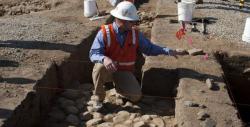
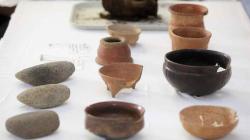 Nuevo Lourdes - Nuevo Lourdes, an archaeological site in central El Salvador, provides insights into daily life in pre-Columbian times in this country and Mesoamerica, experts digging there said. The site is related to everyday life and it was not a ceremonial location like other Mesoamerican areas, Shione Shibata, archaeological director at the Culture Secretariat's Cultural Heritage Directorate, told Efe. Construction workers found the Nuevo Lourdes site while preparing to build a housing project near Lourdes, located in La Libertad province, in 2013. The initial findings two years ago included a wide farm field, an individual's burial site and oblations, at least six cooking pots and assorted fragments from clay, obsidian and stone objects, experts said at the time. The site dates to the late pre-Classical period (about 200 B.C. to A.D. 200), archaeologists said. New excavations between September and October 2014 yielded 15 additional objects, including ceramic vessels and bowls, stone pestles used to grind corn, and two jade beads, which were shown to the media on Jan. 21 in San Salvador. Researchers also found a number of bone fragments, including at least one skull, teeth and other fragments, Michelle Toledo, an archaeologist at the Culture Secretariat, told Efe. The most recent findings, according to archaeologists, date from the late Classical period between A.D. 650 and A.D. 950. Shibata said the New Lourdes site is especially important because the remains indicate it was a place of residence and work. So far, researchers have not determined which pre-Columbian culture the Nuevo Lourdes archaeological site belonged to, and Hugo Diaz, one of the archaeologists involved in the study, said it could be Mayan.
Nuevo Lourdes - Nuevo Lourdes, an archaeological site in central El Salvador, provides insights into daily life in pre-Columbian times in this country and Mesoamerica, experts digging there said. The site is related to everyday life and it was not a ceremonial location like other Mesoamerican areas, Shione Shibata, archaeological director at the Culture Secretariat's Cultural Heritage Directorate, told Efe. Construction workers found the Nuevo Lourdes site while preparing to build a housing project near Lourdes, located in La Libertad province, in 2013. The initial findings two years ago included a wide farm field, an individual's burial site and oblations, at least six cooking pots and assorted fragments from clay, obsidian and stone objects, experts said at the time. The site dates to the late pre-Classical period (about 200 B.C. to A.D. 200), archaeologists said. New excavations between September and October 2014 yielded 15 additional objects, including ceramic vessels and bowls, stone pestles used to grind corn, and two jade beads, which were shown to the media on Jan. 21 in San Salvador. Researchers also found a number of bone fragments, including at least one skull, teeth and other fragments, Michelle Toledo, an archaeologist at the Culture Secretariat, told Efe. The most recent findings, according to archaeologists, date from the late Classical period between A.D. 650 and A.D. 950. Shibata said the New Lourdes site is especially important because the remains indicate it was a place of residence and work. So far, researchers have not determined which pre-Columbian culture the Nuevo Lourdes archaeological site belonged to, and Hugo Diaz, one of the archaeologists involved in the study, said it could be Mayan.
http://latino.foxnews.com/latino/entertainment/2015/01/26/salvadoran-archaeological-site-provides-window-into-pre-columbian-life/?
GRECE – 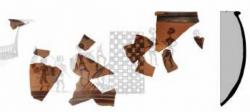 Abai/Kalapodi - Continuity or discontinuity in Greek religion and cult is today a controversially discussed issue. Whereas the great Swedish scholar Martin P. Nilsson was of the firm conviction that the Greek religion of the 1st millennium BC had its roots in the Minoan-Mycenaean religion of the 2nd millennium BC and that the history of a number of Greek sanctuaries goes back to the 2nd millennium BC, some influential present day scholars (F. de Polignac, J. Whitley, I. Morris) refuse this and see a complete break between the 2nd and the 1st millennia BC. Important new evidence concerning this question has recently come to light in the oracle sanctuary of Apollon of Abai in ancient eastern Phokis, near the village of Kalapodi. A sequence of ten temples has been excavated, which demonstrates cult continuity at this place from at least from at least ca. 1400 BC to the 2nd century AD. The first temple was built in LH IIIA 1 and destroyed at the end of LH IIIA 2. After that many votives, among them 27 seal stones, were deposited on the ruin as foundation offering for the second temple. This contained important cult installations: a horseshoe-shaped clay altar and a platform for animal sacrifice. From it come also the fragments of a female terracotta figurine. Temple 2 was destroyed at the end of LH IIIB. After the collapse of the Mycenaean palace system, the LH IIIC-sanctuary with temple 3 formed a meeting point for the newly emerging elite who met at the site for sacrifice and feasting, as rich finds demonstrate. In recent discussions about continuity or discontinuity in cult and religion between the Bronze and Iron Age, the sanctuary at Abai/Kalapodi is named as the only Greek sanctuary showing continuity. This is not true, however, as other recent excavations in the sanctuaries of Athena at Miletus, of Hera on Samos (both excavated by the speaker) and Mt. Lykaion demonstrate. Following these new data it appears worth to re-examine also sanctuaries excavated earlier, as will be demonstrated with the example of Delphi.
Abai/Kalapodi - Continuity or discontinuity in Greek religion and cult is today a controversially discussed issue. Whereas the great Swedish scholar Martin P. Nilsson was of the firm conviction that the Greek religion of the 1st millennium BC had its roots in the Minoan-Mycenaean religion of the 2nd millennium BC and that the history of a number of Greek sanctuaries goes back to the 2nd millennium BC, some influential present day scholars (F. de Polignac, J. Whitley, I. Morris) refuse this and see a complete break between the 2nd and the 1st millennia BC. Important new evidence concerning this question has recently come to light in the oracle sanctuary of Apollon of Abai in ancient eastern Phokis, near the village of Kalapodi. A sequence of ten temples has been excavated, which demonstrates cult continuity at this place from at least from at least ca. 1400 BC to the 2nd century AD. The first temple was built in LH IIIA 1 and destroyed at the end of LH IIIA 2. After that many votives, among them 27 seal stones, were deposited on the ruin as foundation offering for the second temple. This contained important cult installations: a horseshoe-shaped clay altar and a platform for animal sacrifice. From it come also the fragments of a female terracotta figurine. Temple 2 was destroyed at the end of LH IIIB. After the collapse of the Mycenaean palace system, the LH IIIC-sanctuary with temple 3 formed a meeting point for the newly emerging elite who met at the site for sacrifice and feasting, as rich finds demonstrate. In recent discussions about continuity or discontinuity in cult and religion between the Bronze and Iron Age, the sanctuary at Abai/Kalapodi is named as the only Greek sanctuary showing continuity. This is not true, however, as other recent excavations in the sanctuaries of Athena at Miletus, of Hera on Samos (both excavated by the speaker) and Mt. Lykaion demonstrate. Following these new data it appears worth to re-examine also sanctuaries excavated earlier, as will be demonstrated with the example of Delphi.
http://www.archaeology.wiki/blog/2015/01/26/mycenaean-sanctuary-abaikalapodi/
ITALIE - Pompéi - The museum said the reconstruction is the largest model of the ancient city ever made out of Lego blocks. It shows how the town would have looked at the moment of destruction in 79AD, how it looked when it was rediscovered in the 1700s, and how it looks today. Since 2012, the museum has commissioned Mr McNaught to recreate three ancient sites, including a replica of the Colosseum in Rome and the Lego Acropolis. The university said the Lego model helps introduce students to issues of Roman daily life, architecture and the history of the excavations.
Pompéi - The museum said the reconstruction is the largest model of the ancient city ever made out of Lego blocks. It shows how the town would have looked at the moment of destruction in 79AD, how it looked when it was rediscovered in the 1700s, and how it looks today. Since 2012, the museum has commissioned Mr McNaught to recreate three ancient sites, including a replica of the Colosseum in Rome and the Lego Acropolis. The university said the Lego model helps introduce students to issues of Roman daily life, architecture and the history of the excavations.
http://www.dailymail.co.uk/sciencetech/article-2926524/Ancient-Pompeii-revealed-LEGO-190-000-brick-model-shows-town-looked-like-destroyed-79AD.html